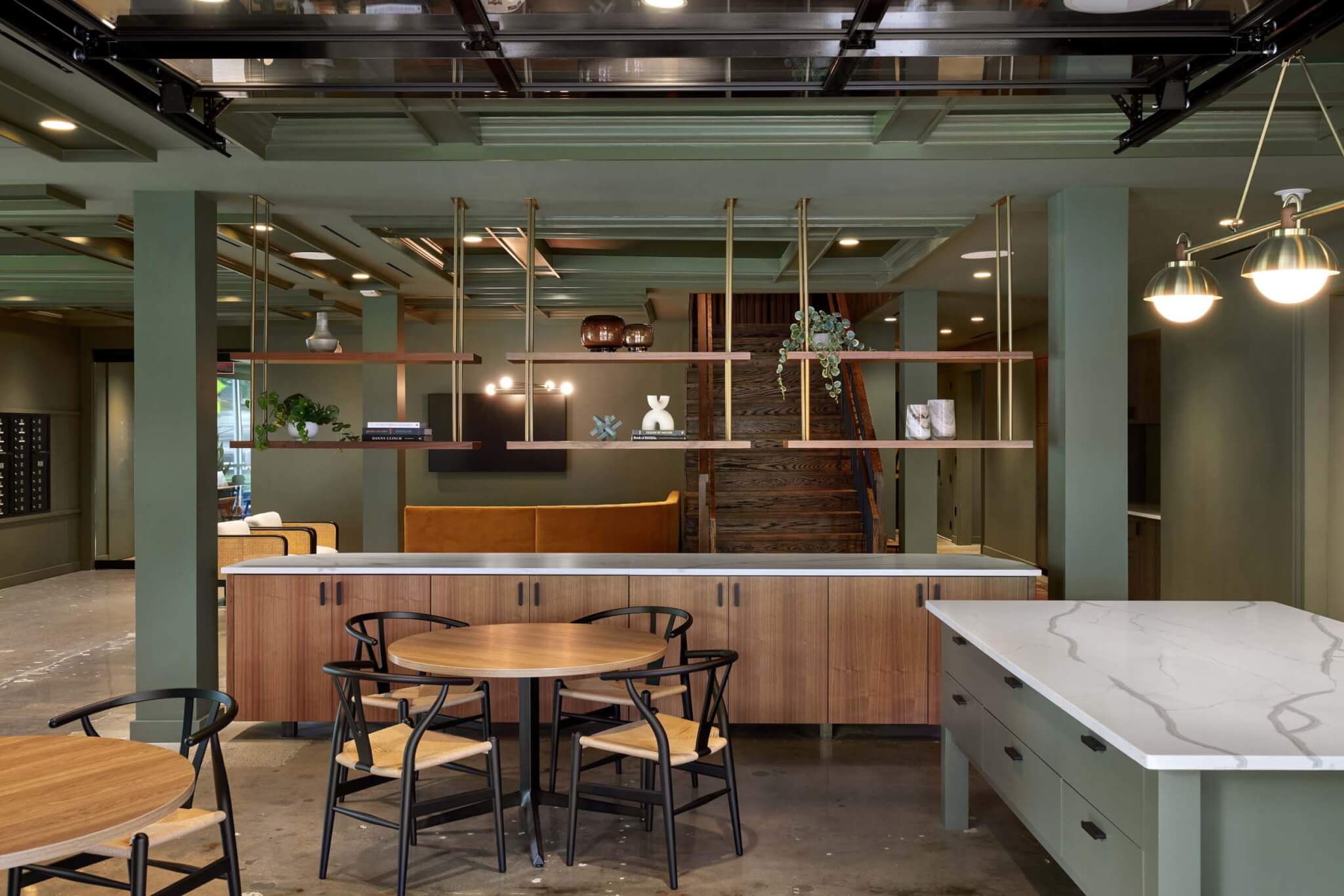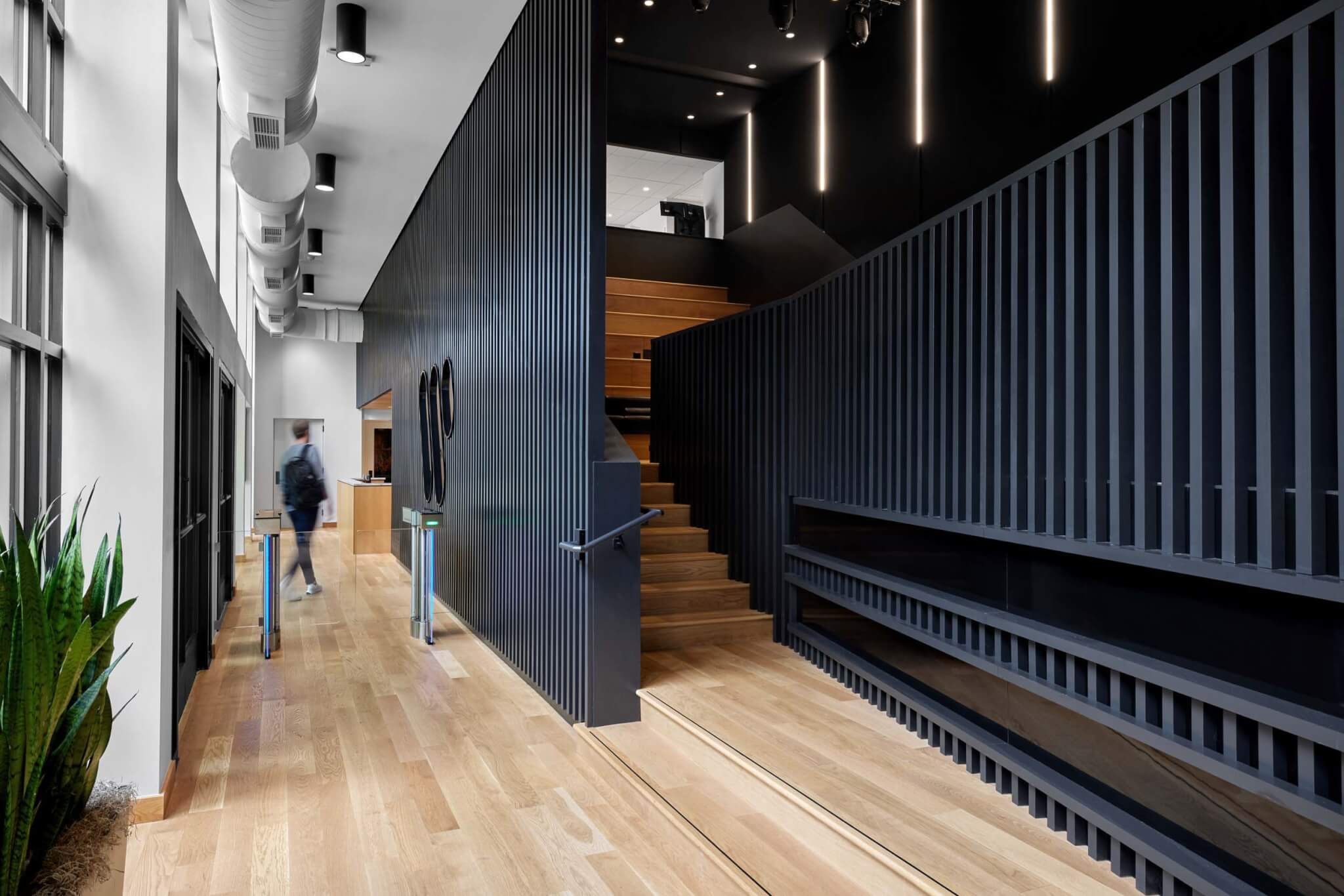Nathan Chapman used to write songs in an office building. The spaces, he said, “weren’t inspiring at all.” A Nashville native and songwriter with Warner Chappell Music, a publishing company, the three-time Grammy Award winner has produced and written with Darius Rucker, Keith Urban, and Taylor Swift, among many others. (Maybe he was able to find some inspiration.) But in an L-shaped building with hospital-like hallways and only a kitchen for a community space, he didn’t know what to do with himself when he was waiting on a cowriter, he says, and he couldn’t always tune out “the sound pollution of other songs” through too-thin walls.
A project nearly 12 years in the making on Nashville’s famed Music Row has changed that. Music Row is a cluster of recording studios, publishing houses, old bungalows, radio stations, and restaurants where deals were made; stars came and went in its alleyways, out of sight. “It has always been a place where you could write, publish, and record within a few blocks,” Ben Kline, the co-president and cochair of Warner Music Nashville, told AN recently. Over time, though, in the decades after Bob Dylan made Blonde on Blonde and Patsy Cline recorded “Walkin’ After Midnight” here, the spaces had begun to deteriorate and disappear.

The Nashville-based firm HASTINGS was engaged to reimagine and reorganize Warner’s two existing buildings on Music Row for the next generation. (To clarify, Warner Chappell publishes music. Warner Music Nashville comprises ten record labels and develops artists. Both are owned by Warner, one of the music industry’s big three companies, with Sony and Universal.) The buildings needed it. With a design led by David Powell, owner and principal of HASTINGS, with Claudia Lofton, an associate at the office, HASTINGS consolidated Warner Chappell’s songwriters in the one from the 1970s, and the Warner Music Nashville label in the one from the ’90s. Chapman now writes in one of the 12 dedicated soundproofed rooms in what used to be moribund administrative space. These rooms are among the most vital parts of the revival of buildings whose fate in a dramatically changing city wasn’t always clear.
Stretching south from Interstate 40, Music Row is divided from splashier parts of Nashville like The Gulch and SoBro, which are being redeveloped as quickly as the capital stacks can be arranged. As an architect, Powell said, he thinks of himself as a storyteller. The story he wanted to tell with this project was about Warner’s role in the city’s history and the company’s support of the people who continue to make it. The project spans a period when Nashville has changed demonstrably. With the advent of streaming platforms and other ways to get and make music, Powell said there was a kind of exodus from Music Row to downtown, with new glass towers mixing with sports stadiums, the Country Music Hall of Fame, the Ryman Auditorium, a food hall, and the low-slung, scuzzy buildings always buzzing with tipsy tourists on Broadway.

At first, Warner thought it might want to scrape the sites and start over. But it was important, Powell emphasized, to stay on Music Row. “Why leave?” asked Warner Music Nashville’s longtime CEO, John Esposito. The City of Nashville’s planning department had also created the code-based Vision Plan to encourage the preservation of the fabric of Music Row. The concept for the project moved in this direction, befitting a city in transition whose most interesting spaces—Attaboy, Pinewood Social, the remade Ryman—bring the old and the new together.

The 14,000-square-foot Warner Chappell building, where Chapman now writes, is a workspace that feels like “a third space,” what the sociologist Ray Oldenburg called the bars or coffee shops where we spend free time. Inside, the first floor was stripped back and reimagined as a kind of low-key lounge. Copies of the writers’ favorite books are scattered on shelves. The first floor connects to a patio where Chapman often eats lunch and a second, living room–like space where a well-stocked bar and a small stage provide for impromptu performances. The writers’ rooms are on the second floor. They open to a third lounge reminiscent of an East Nashville bar, with vintage rugs and a Led Zeppelin pinball machine. With these spaces, Chapman said, “you get a sense of community, and then you get to go off in your own little world and work.”

Warner Music Nashville’s 35,900-square-foot building, where Chapman used to write, sits across Music Row to the east. Now the company’s leadership and A&R teams are concentrated here in refreshed offices. A recording studio has been added on the second floor to replace the dated one that had been across the street. HASTINGS’s most dramatic move was undoing the building’s original entrance, with an uncomfortable lobby greeting everyone with a wall and forcing them to climb rhyming staircases in either direction. Now a screen of wooden beams obscures and reveals a performance space for label showcases. HASTINGS cut down into the parking garage to create a double-height cavern of a black box with a stage, lighting, and stadium seats that function during the day as a social stairway.
The story HASTINGS tells with these buildings, which were completed last year, is a quiet one in the end. The buildings have a well-developed interiority, but the exteriors are subtle. If you didn’t know better, you’d mistake the flat black paint on the Chappell building for a sign of gentrification. (There is a similar building, an old motel that’s been souped up into luxury rentals, near downtown.) But here, as it turns out, the treatment is an expression of the company’s brand, whose color scheme also includes a brassy gold.

It’s a harder story to tell, a story of the choices not made. A new tower or a void and a historic marker are blunt in a way these buildings refuse to be. They know why they’re here. Powell was in a band when he first moved to Nashville. He’s a drummer. He still has that energy; his right knee bounces at times as though he were playing an invisible kick drum. This project is an expression of these two talents: knowing how to set things up and then getting out of the way. “All you need to write a song,” Powell said, quoting the country legend Harlan Howard from the 1950s, “is three chords and the truth.”
Allyn West is a writer based in Houston and rural Kentucky. You can find them on Twitter @allynwest.










